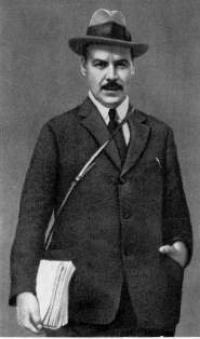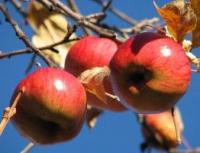You are here
Origin of Sievers apple tree.


Wild apple forests of Kazakhstan.
“Alma-Ata literally means “father of apples.” Around the city, at a great distance along the mountain slopes, thickets of wild apple trees stretch, making up entire forests here. Unlike small Caucasian wild apple trees, Kazakhstan wild apple trees are predominantly represented by large-fruited varieties that differ little from cultivated varieties. It was September 1st, the time for apples to ripen. One could see with one’s own eyes that here we are in a remarkable center of origin of the cultivated apple tree, where cultivated forms imperceptibly merge with wild ones, where it is difficult to distinguish a wild apple tree from a cultivated one. Some forms in the forest are so good in fruit quality and size that they can simply be transferred to the garden. In the cultural gardens here you can see the best European assortment, starting with the famous “aport”.
Nikolay Vavilov. "Western China". 1929.
Sivers apple tree in Central Asia.
According to scientists, apple trees were domesticated a long time ago - 4000 years ago. Since there are several centers of growth of this fruit, for a long time scientists could not accurately lean towards any of them. The championship was occupied on the one hand by Türkiye, on the other by Central Asia.
Despite the fact that the first description of this type of apple tree dates back to 1793 and is tied to the territory of modern Kazakhstan, many contemporaries denied until recently that apples spread throughout the world precisely from the mountain apple massifs of the Tien-Shan.
But in 2002, Oxford University genetics professor Barry Juniper confirmed the hypothesis that the Sievers apple tree (Malus sieversii) is the “mother of all apples.” He supported his statement with undeniable arguments - the result of molecular genetic studies of materials collected in the wild apple forests of Kazakhstan.
A set of small mutations in apple genes (117 samples), common in Europe and Asia, was compared with the DNA of their putative wild relatives. As a result, they were able to reconstruct the genome of a common ancestor.
And now there is no longer any doubt - it is the Kazakh Tien-Shan that is the Eden of the apple - a fruit that is in the TOP-3 most useful and popular. The Sivers apple tree is the ancestor of all apples on the planet.
But now its forests are under threat of extinction. Over the last 150 - 200 years alone, the vast forests in the foothills of the Tien-Shan have decreased by 95%. After studying the research results, Benetton Foundation scientists decided to help protect the mountain apple tracts of the Tien-Shan, which helped the Kazakh authorities in preserving these places.
Caspian University was also involved in this process: students and staff of the university go to apple forests on a voluntary basis and carry out the necessary measures to protect apple trees and collect materials for Kazakh scientists.
Caspai University works in close connection with the International Foundation for the Conservation of the Sievers Apple Tree, created in 2017. In addition to its historical value, the Sievers apple tree has great biological significance.
The unique strong DNA structure, and most importantly - not spoiled by ennobled varieties, has incredible resistance both to various diseases and to critical, low environmental temperatures. It is known that apple trees growing on the slopes of the Dzhungarskiy Alatau calmly survive both forty-degree heat and frost.
While gardeners may die with more loyal indicators. This stability is explained by the fact that the Sievers apple tree has been growing on the earth for more than one millennium. There is no exact date of origin of this unique tree, and it is unknown in what geological period the genus Malus began to form.
But still, archaeological finds suggest the possibility that dinosaurs admired the blooming apple orchards. There are publications by scientists with data on the discovery of apple fruits in Western Siberia in a layer of earth dating from the Tertiary period, that is, from 1.8 to 65 million years BC.
Having survived dinosaurs and all the natural disasters of millennia, the apple tree could not withstand the most important thing - the appearance of man...
The Sievers apple tree is a tree 2 - 6 to 12 meters high with gray-brown or dark gray shoots. Leaves are 6 - 11 cm long, 3 - 3.5 wide, broadly lanceolate or oblong-elliptic. The flowers are white or pink of varying intensity, 3.5 - 6 cm in diameter, collected in 3 - 5 flower corymbs.
The leaves are elliptical or rounded, pointed at the top, jagged or serrate along the edges, young ones are heavily pubescent, especially below, adults are bare, glossy on top. Flowers in few-flowered corymbs on short shoots.
The corolla is white or pink, 3 - 4 (up to 5) cm in diameter, stamens 18 - 50, pistil with 5 styles and stigmas and a lower ovary. Fruits of different shapes, sizes and colors. The most common spherical fruits are yellow in color.
It blooms in April - May, simultaneously with the leaves blooming. The fruits ripen in July - September. It begins to bear fruit at the age of 5 - 10 years. One mature tree produces several tens and even hundreds of kilograms of fruit.
Fruiting is periodic (fruitful years alternate with lean years). In nature, it reproduces mainly by seed. Birds and mammals play a major role in seed dispersal. The scientific name Sievers apple tree comes from the estate of a pharmacist from St. Petersburg, John Sivers, who first described it in 1827.
Later in 1929, the great Russian scientist N. Vavilov, during an expedition to Central Asia, suggested that this is where one of the 11 world centers of origin of cultivated agricultural species is located. He characterized the southeast of Kazakhstan as a separate center of intraspecific diversity of wild apple and apricot trees, the gene pool of which is of interest for the selection of these crops.
This assumption was later confirmed by the results of many years of work by the Kazakh scientist, a pioneer in the study of wild apple trees, academician Aimak Dzhangaliev, as well as his foreign colleagues. The discovery of the primary center of origin of the domestic apple tree in the mountainous regions of Central Asia was first reported at the International Genetics Congress in Moscow in 1978. And at the end of the last century, academician A. Dzhangaliev organized several international expeditions to the Zailiskiy and Dzungarskiy Alatau, which gave absolutely stunning results.
A molecular genetic study of the germplasm taken by scientists from England, the USA, France, Germany, and Canada unambiguously confirmed that our wild apple tree served as the progenitor source of most cultivated varieties of apple trees, the number of which is about 15,000 in the world.
Along the Great Silk Road, the apple tree spread first to Iraq and Turkey, then to Europe and throughout the world. Within its natural range, the Sievers apple tree is characterized by striking intraspecific diversity. Unique natural conditions determined the extraordinary richness of morphological and biological characteristics.
In the apple forest you can find trees with fruits of various tastes, colors, and sizes.
Authority:
http://fungi.su/articles.php?article_id=221
https://botsad.volgatech.net/novosti/Osnovnye_novosti/405354/
Photos by:
Alexander Petrov.







